Abstract
We previously reported that the expression on the primary tumour of the antigen CaMBr8 was related to a short survival, attributable either to higher tumour aggressiveness or a poor response to oophorectomy. To further verify the CaMBr8 prognostic value, we analysed retrospectively 862 breast cancer patients with a 19 year follow-up. In this series, CaMBr8 expression was found to be associated to some negative prognostic factors (premenopausal status, lymphnode invasion, a high number of mitosis and HER-2/neu oncoprotein expression), but had no influence on the patients' survival. Direct association with a poor prognosis was only evident in patients with lobular or mixed breast carcinoma, which however represent only a small fraction of the total breast cancers. Another possibility was that CaMBr8 could identify a subgroup of patients which did not respond to hormone therapy. To verify this hypothesis we evaluated on a second series of 116 patients the relationship between CaMBr8 expression and hormone-receptor levels. A negative association emerged which was also observed in vitro in the human breast cancer line MCF-7 treated with Sodium Butyrate, a differentiation inducer, which reduced hormone-receptor levels and increased CaMBr8 expression. In conclusion, the longer survival of CaMBr8 negative tumour patients observed in the initial study, was probably related to a better response to oophorectomy, due to the hormone-receptor level of their tumours.
Full text
PDF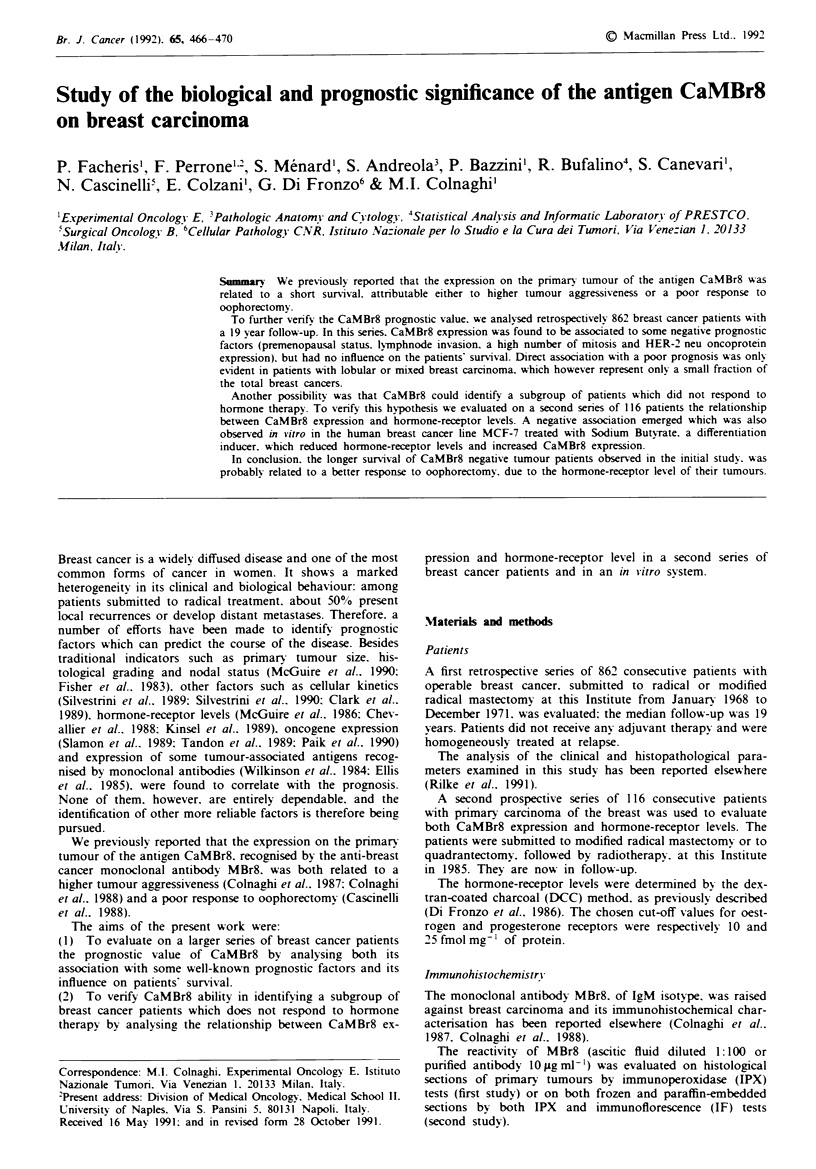
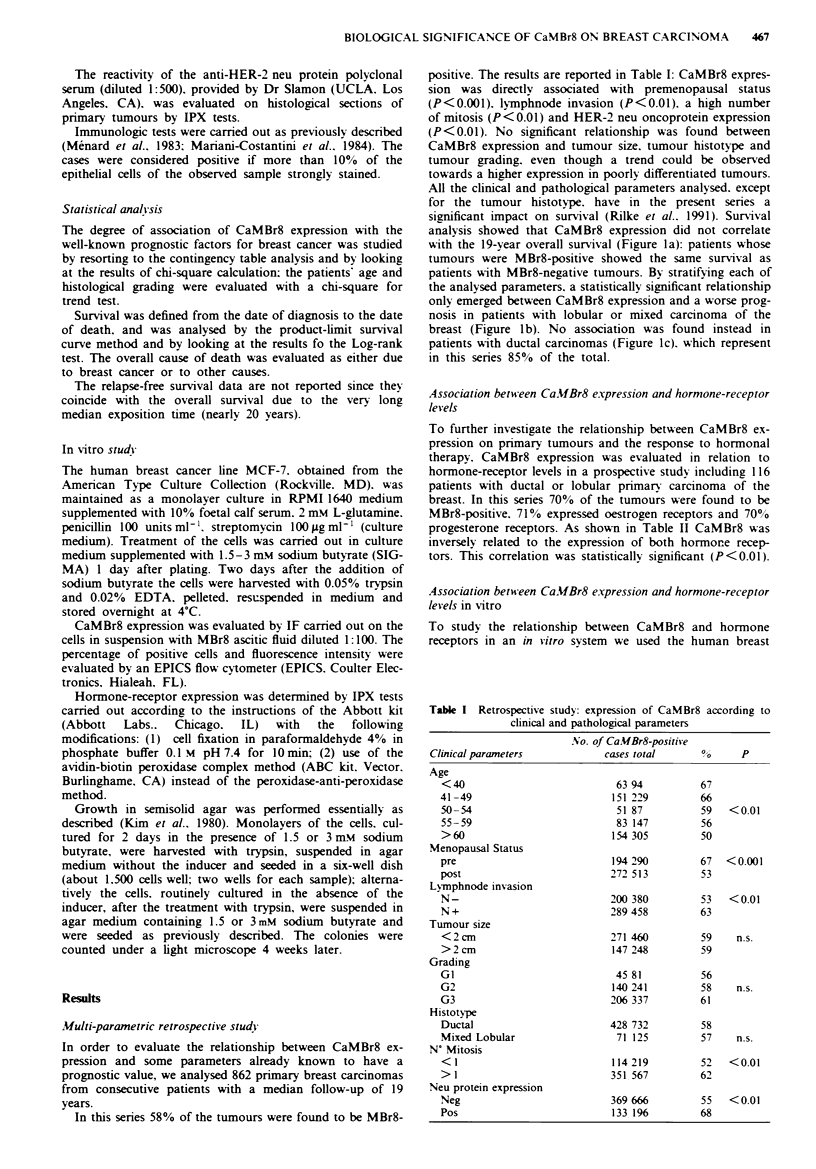
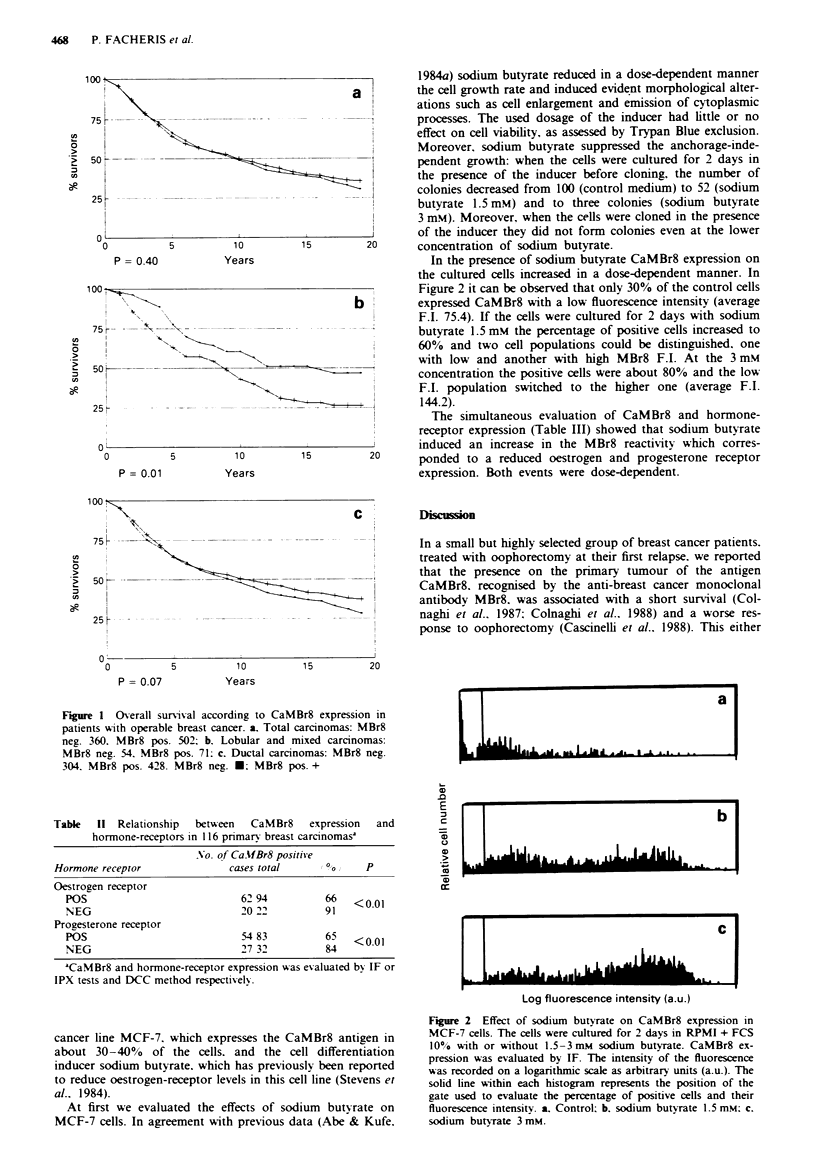
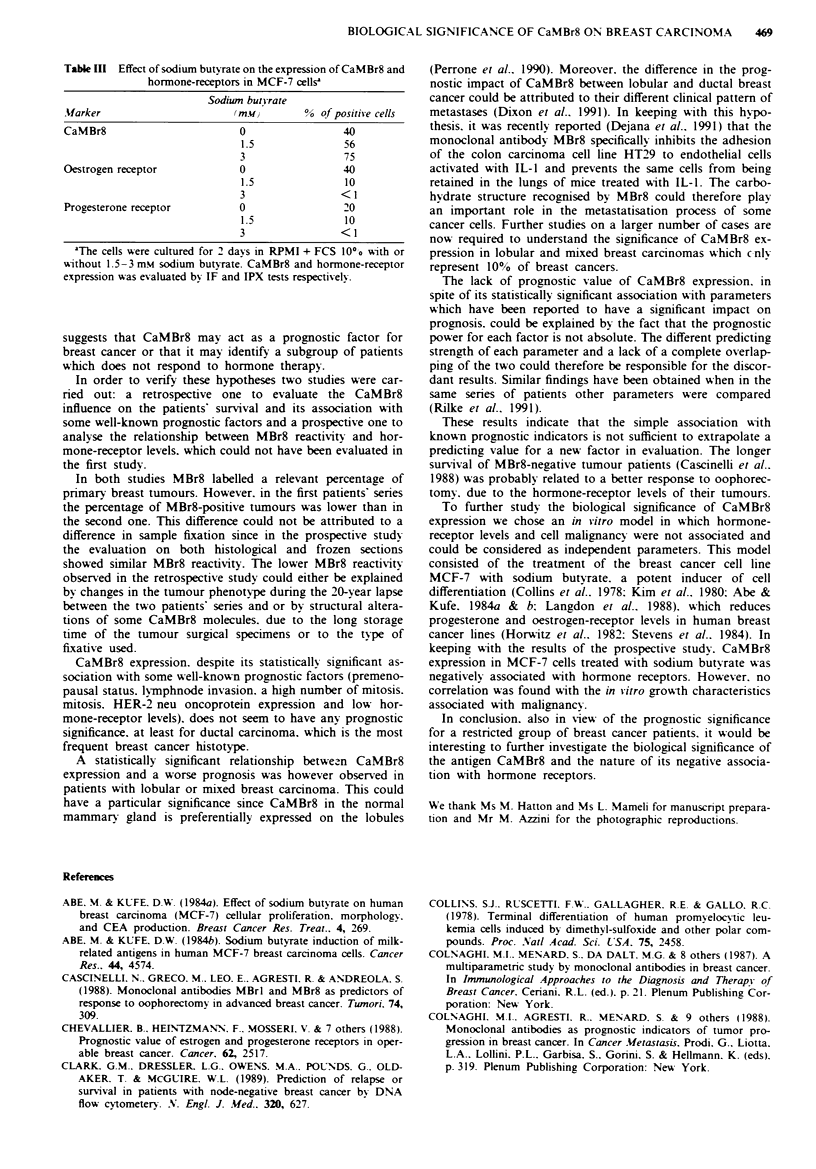
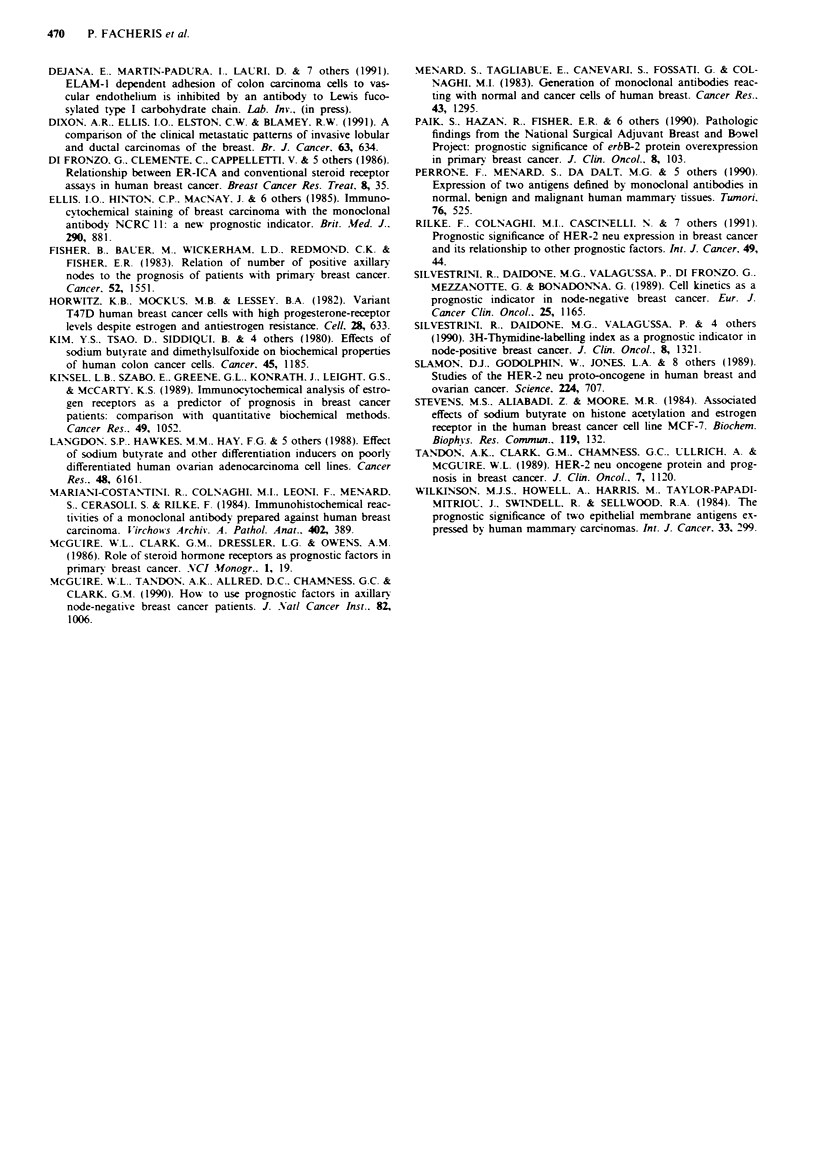
Selected References
These references are in PubMed. This may not be the complete list of references from this article.
- Abe M., Kufe D. W. Effect of sodium butyrate on human breast carcinoma (MCF-7) cellular proliferation, morphology, and CEA production. Breast Cancer Res Treat. 1984;4(4):269–274. doi: 10.1007/BF01806038. [DOI] [PubMed] [Google Scholar]
- Abe M., Kufe D. W. Sodium butyrate induction of milk-related antigens in human MCF-7 breast carcinoma cells. Cancer Res. 1984 Oct;44(10):4574–4577. [PubMed] [Google Scholar]
- Cascinelli N., Greco M., Leo E., Agresti R., Andreola S. Monoclonal antibodies MBr1 and MBr8 as predictors of response to oophorectomy in advanced breast cancer. Tumori. 1988 Jun 30;74(3):309–312. doi: 10.1177/030089168807400311. [DOI] [PubMed] [Google Scholar]
- Chevallier B., Heintzmann F., Mosseri V., Dauce J. P., Bastit P., Graic Y., Brunelle P., Basuyau J. P., Comoz M., Asselain B. Prognostic value of estrogen and progesterone receptors in operable breast cancer. Results of a univariate and multivariate analysis. Cancer. 1988 Dec 15;62(12):2517–2524. doi: 10.1002/1097-0142(19881215)62:12<2517::aid-cncr2820621211>3.0.co;2-9. [DOI] [PubMed] [Google Scholar]
- Clark G. M., Dressler L. G., Owens M. A., Pounds G., Oldaker T., McGuire W. L. Prediction of relapse or survival in patients with node-negative breast cancer by DNA flow cytometry. N Engl J Med. 1989 Mar 9;320(10):627–633. doi: 10.1056/NEJM198903093201003. [DOI] [PubMed] [Google Scholar]
- Collins S. J., Ruscetti F. W., Gallagher R. E., Gallo R. C. Terminal differentiation of human promyelocytic leukemia cells induced by dimethyl sulfoxide and other polar compounds. Proc Natl Acad Sci U S A. 1978 May;75(5):2458–2462. doi: 10.1073/pnas.75.5.2458. [DOI] [PMC free article] [PubMed] [Google Scholar]
- Dixon A. R., Ellis I. O., Elston C. W., Blamey R. W. A comparison of the clinical metastatic patterns of invasive lobular and ductal carcinomas of the breast. Br J Cancer. 1991 Apr;63(4):634–635. doi: 10.1038/bjc.1991.145. [DOI] [PMC free article] [PubMed] [Google Scholar]
- Ellis I. O., Hinton C. P., MacNay J., Elston C. W., Robins A., Owainati A. A., Blamey R. W., Baldwin R. W., Ferry B. Immunocytochemical staining of breast carcinoma with the monoclonal antibody NCRC 11: a new prognostic indicator. Br Med J (Clin Res Ed) 1985 Mar 23;290(6472):881–883. doi: 10.1136/bmj.290.6472.881. [DOI] [PMC free article] [PubMed] [Google Scholar]
- Fisher B., Bauer M., Wickerham D. L., Redmond C. K., Fisher E. R., Cruz A. B., Foster R., Gardner B., Lerner H., Margolese R. Relation of number of positive axillary nodes to the prognosis of patients with primary breast cancer. An NSABP update. Cancer. 1983 Nov 1;52(9):1551–1557. doi: 10.1002/1097-0142(19831101)52:9<1551::aid-cncr2820520902>3.0.co;2-3. [DOI] [PubMed] [Google Scholar]
- Horwitz K. B., Mockus M. B., Lessey B. A. Variant T47D human breast cancer cells with high progesterone-receptor levels despite estrogen and antiestrogen resistance. Cell. 1982 Mar;28(3):633–642. doi: 10.1016/0092-8674(82)90218-5. [DOI] [PubMed] [Google Scholar]
- Kim Y. S., Tsao D., Siddiqui B., Whitehead J. S., Arnstein P., Bennett J., Hicks J. Effects of sodium butyrate and dimethylsulfoxide on biochemical properties of human colon cancer cells. Cancer. 1980 Mar 15;45(5 Suppl):1185–1192. doi: 10.1002/1097-0142(19800315)45:5+<1185::aid-cncr2820451324>3.0.co;2-w. [DOI] [PubMed] [Google Scholar]
- Kinsel L. B., Szabo E., Greene G. L., Konrath J., Leight G. S., McCarty K. S., Jr Immunocytochemical analysis of estrogen receptors as a predictor of prognosis in breast cancer patients: comparison with quantitative biochemical methods. Cancer Res. 1989 Feb 15;49(4):1052–1056. [PubMed] [Google Scholar]
- Langdon S. P., Hawkes M. M., Hay F. G., Lawrie S. S., Schol D. J., Hilgers J., Leonard R. C., Smyth J. F. Effect of sodium butyrate and other differentiation inducers on poorly differentiated human ovarian adenocarcinoma cell lines. Cancer Res. 1988 Nov 1;48(21):6161–6165. [PubMed] [Google Scholar]
- Mariani-Costantini R., Colnaghi M. I., Leoni F., Mènard S., Cerasoli S., Rilke F. Immunohistochemical reactivity of a monoclonal antibody prepared against human breast carcinoma. Virchows Arch A Pathol Anat Histopathol. 1984;402(4):389–404. doi: 10.1007/BF00734636. [DOI] [PubMed] [Google Scholar]
- McGuire W. L., Tandon A. K., Allred D. C., Chamness G. C., Clark G. M. How to use prognostic factors in axillary node-negative breast cancer patients. J Natl Cancer Inst. 1990 Jun 20;82(12):1006–1015. doi: 10.1093/jnci/82.12.1006. [DOI] [PubMed] [Google Scholar]
- Mènard S., Tagliabue E., Canevari S., Fossati G., Colnaghi M. I. Generation of monoclonal antibodies reacting with normal and cancer cells of human breast. Cancer Res. 1983 Mar;43(3):1295–1300. [PubMed] [Google Scholar]
- Paik S., Hazan R., Fisher E. R., Sass R. E., Fisher B., Redmond C., Schlessinger J., Lippman M. E., King C. R. Pathologic findings from the National Surgical Adjuvant Breast and Bowel Project: prognostic significance of erbB-2 protein overexpression in primary breast cancer. J Clin Oncol. 1990 Jan;8(1):103–112. doi: 10.1200/JCO.1990.8.1.103. [DOI] [PubMed] [Google Scholar]
- Perrone F., Ménard S., Da Dalt M. G., Leoni F., Di Palma S., Patriarca C., Rilke F., Colnaghi M. I. Expression of two antigens defined by monoclonal antibodies in normal, benign and malignant human mammary tissues. Tumori. 1990 Dec 31;76(6):525–529. doi: 10.1177/030089169007600601. [DOI] [PubMed] [Google Scholar]
- Rilke F., Colnaghi M. I., Cascinelli N., Andreola S., Baldini M. T., Bufalino R., Della Porta G., Ménard S., Pierotti M. A., Testori A. Prognostic significance of HER-2/neu expression in breast cancer and its relationship to other prognostic factors. Int J Cancer. 1991 Aug 19;49(1):44–49. doi: 10.1002/ijc.2910490109. [DOI] [PubMed] [Google Scholar]
- Silvestrini R., Daidone M. G., Valagussa P., Di Fronzo G., Mezzanotte G., Bonadonna G. Cell kinetics as a prognostic indicator in node-negative breast cancer. Eur J Cancer Clin Oncol. 1989 Aug;25(8):1165–1171. doi: 10.1016/0277-5379(89)90410-0. [DOI] [PubMed] [Google Scholar]
- Silvestrini R., Daidone M. G., Valagussa P., Di Fronzo G., Mezzanotte G., Mariani L., Bonadonna G. 3H-thymidine-labeling index as a prognostic indicator in node-positive breast cancer. J Clin Oncol. 1990 Aug;8(8):1321–1326. doi: 10.1200/JCO.1990.8.8.1321. [DOI] [PubMed] [Google Scholar]
- Slamon D. J., Godolphin W., Jones L. A., Holt J. A., Wong S. G., Keith D. E., Levin W. J., Stuart S. G., Udove J., Ullrich A. Studies of the HER-2/neu proto-oncogene in human breast and ovarian cancer. Science. 1989 May 12;244(4905):707–712. doi: 10.1126/science.2470152. [DOI] [PubMed] [Google Scholar]
- Stevens M. S., Aliabadi Z., Moore M. R. Associated effects of sodium butyrate on histone acetylation and estrogen receptor in the human breast cancer cell line MCF-7. Biochem Biophys Res Commun. 1984 Feb 29;119(1):132–138. doi: 10.1016/0006-291x(84)91628-0. [DOI] [PubMed] [Google Scholar]
- Tandon A. K., Clark G. M., Chamness G. C., Ullrich A., McGuire W. L. HER-2/neu oncogene protein and prognosis in breast cancer. J Clin Oncol. 1989 Aug;7(8):1120–1128. doi: 10.1200/JCO.1989.7.8.1120. [DOI] [PubMed] [Google Scholar]
- Wilkinson M. J., Howell A., Harris M., Taylor-Papadimitriou J., Swindell R., Sellwood R. A. The prognostic significance of two epithelial membrane antigens expressed by human mammary carcinomas. Int J Cancer. 1984 Mar 15;33(3):299–304. doi: 10.1002/ijc.2910330304. [DOI] [PubMed] [Google Scholar]


